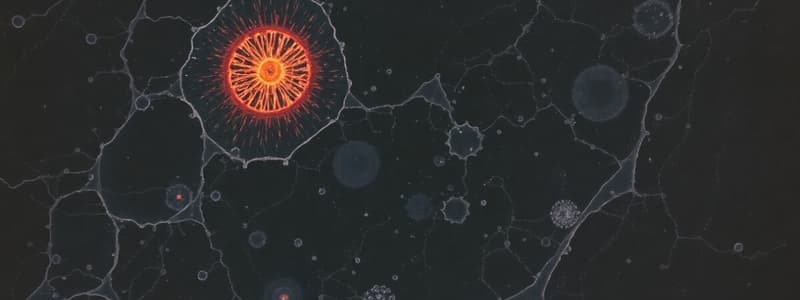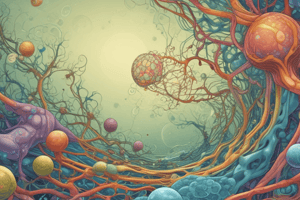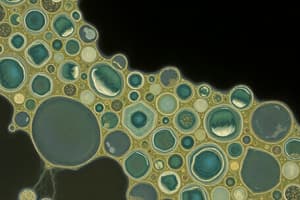Podcast
Questions and Answers
Which cellular component is primarily responsible for modifying and packaging proteins and lipids?
Which cellular component is primarily responsible for modifying and packaging proteins and lipids?
- Golgi Apparatus (correct)
- Lysosomes
- Endoplasmic Reticulum (ER)
- Mitochondria
Which of the following structures is NOT part of the endomembrane system?
Which of the following structures is NOT part of the endomembrane system?
- Mitochondrion (correct)
- Lysosome
- Endoplasmic reticulum
- Golgi apparatus
What is the primary function of the smooth endoplasmic reticulum (SER)?
What is the primary function of the smooth endoplasmic reticulum (SER)?
- ATP production
- Protein synthesis
- Lipid synthesis and detoxification (correct)
- Digesting cellular waste
Which type of plastid is responsible for storing starch in plant cells?
Which type of plastid is responsible for storing starch in plant cells?
The 'Fluid Mosaic Model' describes the structure of which cellular component?
The 'Fluid Mosaic Model' describes the structure of which cellular component?
What is the main component of the middle lamella that holds plant cells together?
What is the main component of the middle lamella that holds plant cells together?
Which of the following is a characteristic feature of prokaryotic cells?
Which of the following is a characteristic feature of prokaryotic cells?
What is the primary function of mesosomes in prokaryotic cells?
What is the primary function of mesosomes in prokaryotic cells?
Which of the following structures is directly involved in the locomotion of a bacterial cell?
Which of the following structures is directly involved in the locomotion of a bacterial cell?
What is the significance of the 9+2 arrangement of microtubules in eukaryotic cilia and flagella?
What is the significance of the 9+2 arrangement of microtubules in eukaryotic cilia and flagella?
Which process does NOT directly involve the cell membrane?
Which process does NOT directly involve the cell membrane?
Which component of the cytoskeleton is primarily involved in providing mechanical support and maintaining cell shape?
Which component of the cytoskeleton is primarily involved in providing mechanical support and maintaining cell shape?
Which of the following cellular structures is responsible for the synthesis of ribosomal RNA (rRNA)?
Which of the following cellular structures is responsible for the synthesis of ribosomal RNA (rRNA)?
How do substances move across the cell membrane during active transport?
How do substances move across the cell membrane during active transport?
According to the cell theory, from where do new cells arise?
According to the cell theory, from where do new cells arise?
What is the function of the contractile vacuole found in some protists like Amoeba?
What is the function of the contractile vacuole found in some protists like Amoeba?
In eukaryotic cells, where does the Krebs cycle take place?
In eukaryotic cells, where does the Krebs cycle take place?
What is the primary function of lysosomes?
What is the primary function of lysosomes?
A cell observed under a microscope has a cell wall, a nucleus, and chloroplasts. Which type of cell is it most likely to be?
A cell observed under a microscope has a cell wall, a nucleus, and chloroplasts. Which type of cell is it most likely to be?
What is the role of the centromere in a chromosome?
What is the role of the centromere in a chromosome?
Flashcards
Cell
Cell
The fundamental structural and functional unit of all living organisms.
Cell Theory states
Cell Theory states
All living organisms are composed of cells and their products, and new cells arise from pre-existing cells.
Prokaryotic Cells
Prokaryotic Cells
Cells lacking a membrane-bound nucleus and other membrane-bound organelles.
Eukaryotic Cells
Eukaryotic Cells
Signup and view all the flashcards
Cell Wall
Cell Wall
Signup and view all the flashcards
Endomembrane System
Endomembrane System
Signup and view all the flashcards
Endoplasmic Reticulum (ER)
Endoplasmic Reticulum (ER)
Signup and view all the flashcards
Golgi Apparatus
Golgi Apparatus
Signup and view all the flashcards
Lysosomes
Lysosomes
Signup and view all the flashcards
Vacuoles
Vacuoles
Signup and view all the flashcards
Mitochondria
Mitochondria
Signup and view all the flashcards
Plastids
Plastids
Signup and view all the flashcards
Ribosomes
Ribosomes
Signup and view all the flashcards
Cytoskeleton
Cytoskeleton
Signup and view all the flashcards
Cilia and Flagella
Cilia and Flagella
Signup and view all the flashcards
Centrosome
Centrosome
Signup and view all the flashcards
Nucleus
Nucleus
Signup and view all the flashcards
Chromosomes
Chromosomes
Signup and view all the flashcards
Cell Membrane
Cell Membrane
Signup and view all the flashcards
Microbodies
Microbodies
Signup and view all the flashcards
Study Notes
- The cell is the fundamental structural and functional unit of all living organisms.
- All living organisms are composed of cells and their products.
Cell Theory
- Proposed by Matthias Schleiden and Theodor Schwann in 1839.
- States that all plants and animals are composed of cells.
- Rudolf Virchow expanded the cell theory, stating that new cells arise from pre-existing cells (Omnis cellula e cellula).
- The cell theory states: all living organisms are composed of cells and products of cells; all cells arise from pre-existing cells.
Overview of the Cell
- Cells vary significantly in shape, size, and activities.
- Mycoplasmas are the smallest cells (0.3 μm in length).
- Human red blood cells are about 7.0 μm in diameter.
- Bacteria range from 3 to 5 μm in size.
- The largest single cell is the egg of an ostrich.
- Nerve cells are among the longest cells.
- Cells can have diverse shapes like disc-like, polygonal, columnar, cuboid, thread-like, or irregular.
Prokaryotic Cells
- Lack a membrane-bound nucleus and other membrane-bound organelles.
- Generally smaller and simpler than eukaryotic cells.
- Represented by bacteria, archaea, mycoplasmas, and PPLO (Pleuro Pneumonia Like Organisms).
- Genetic material is essentially naked, not enveloped by a nuclear membrane.
- Have a cell wall surrounding the cell membrane, except in mycoplasmas.
- Plasmids: Circular DNA outside the genomic DNA, conferring unique phenotypic characters like antibiotic resistance.
- Mesosomes: Infoldings of the cell membrane, aiding in cell wall formation, DNA replication, and respiration.
- Flagella: Thin filamentous extensions from the cell wall, used for motility.
- Pili and Fimbriae: Surface structures that attach bacteria to rocks in streams and the host's tissues.
Eukaryotic Cells
- Have membrane-bound organelles, including a nucleus.
- Found in protists, plants, animals, and fungi.
- Possess an organized nucleus with a nuclear envelope.
- Have a variety of complex locomotory and cytoskeletal structures.
Cell Membrane
- Composed of a lipid bilayer with proteins.
- Lipids are arranged with the polar head towards the outer sides and the hydrophobic tails towards the inner part.
- Integral proteins are partially or totally buried in the membrane.
- Peripheral proteins lie on the surface of the membrane.
- Fluid Mosaic Model: Proposed by Singer and Nicolson in 1972, describes the membrane as a fluid structure with proteins dispersed in the lipid bilayer.
- Membrane functions include transport of molecules across it.
- Passive transport: Movement of substances across the membrane without energy, via diffusion.
- Osmosis: Movement of water across the membrane from an area of high water concentration to low water concentration.
- Active transport: Movement of substances across the membrane using energy (ATP).
- Sodium-potassium pump: An example of active transport.
Cell Wall
- A non-living rigid structure that provides shape and protection to the cell.
- Found in plant cells and fungi.
- Algae have cell walls made of cellulose, galactans, mannans, and minerals like calcium carbonate.
- Plant cell walls consist of cellulose, hemicellulose, pectins, and proteins.
- Middle lamella: A layer mainly of calcium pectate which glues the cell walls of adjacent cells together.
- Plasmodesmata: Cytoplasmic connections between neighboring cells, facilitating transport and communication.
Endomembrane System
- A group of membrane-bound organelles that coordinate their functions.
- Includes the endoplasmic reticulum, Golgi apparatus, lysosomes, and vacuoles.
Endoplasmic Reticulum (ER)
- A network of tubules and sacs (cisternae) that extends throughout the cytoplasm.
- Rough ER (RER): Has ribosomes attached to its surface, involved in protein synthesis and secretion.
- Smooth ER (SER): Lacks ribosomes, involved in lipid synthesis, steroid hormone synthesis, and detoxification.
Golgi Apparatus
- Consists of flattened, disc-shaped sacs or cisternae.
- Has two faces: cis (forming) face and trans (maturing) face.
- Functions include packaging materials, modifying proteins and lipids, and forming glycoproteins and glycolipids.
Lysosomes
- Membrane-bound vesicular structures containing hydrolytic enzymes.
- Enzymes are optimally active at acidic pH.
- Functions include digesting cellular waste and foreign materials.
Vacuoles
- Membrane-bound space found in the cytoplasm.
- Contains water, sap, excretory products, and other materials.
- In plant cells, vacuoles can occupy up to 90% of the cell volume, maintaining turgor pressure.
- In Amoeba, contractile vacuole helps in excretion.
- Food vacuoles are formed by engulfing food particles.
Mitochondria
- Double-membrane-bound organelles, considered the "powerhouses" of the cell.
- Outer membrane is smooth, inner membrane is folded into cristae.
- Cristae increase the surface area for ATP generation.
- Matrix contains enzymes for the Krebs cycle, DNA, RNA, and ribosomes.
- Carry out cellular respiration to produce ATP.
Plastids
- Found in plant cells and euglenoids.
- Chloroplasts: Contain chlorophyll, involved in photosynthesis.
- Chromoplasts: Contain carotenoid pigments, responsible for color in flowers and fruits.
- Leucoplasts: Colorless plastids, store nutrients like starch (amyloplast), oils (elaioplast), and proteins (aleuroplast).
- Chloroplast structure includes grana (stacks of thylakoids) and stroma.
- Thylakoids contain chlorophyll.
- Stroma contains enzymes for the Calvin cycle, DNA, RNA, and ribosomes.
Ribosomes
- Granular structures composed of RNA and proteins.
- Not membrane-bound.
- Eukaryotic ribosomes are 80S (60S and 40S subunits).
- Prokaryotic ribosomes are 70S (50S and 30S subunits).
- Site of protein synthesis.
- Polyribosomes or polysomes: Several ribosomes attached to a single mRNA.
Cytoskeleton
- A network of protein filaments in the cytoplasm.
- Provides mechanical support, motility, and maintains the shape of the cell.
- Includes microtubules, microfilaments, and intermediate filaments.
Cilia and Flagella
- Hair-like outgrowths from the cell membrane.
- Cilia are small and numerous, flagella are longer and fewer.
- Structure: Axoneme with nine pairs of peripheral microtubules and two centrally located microtubules (9+2 arrangement).
Centrosome and Centrioles
- Centrosome contains two centrioles.
- Centrioles are cylindrical structures made of microtubules.
- Involved in cell division, forming the spindle apparatus.
Nucleus
- Contains the cell's genetic material (DNA).
- Nuclear envelope: Double-membrane structure enclosing the nucleus.
- Nuclear pores: Openings in the nuclear envelope, allowing transport of molecules.
- Nucleolus: Site of ribosome synthesis.
- Chromatin: DNA and protein fibers that condense to form chromosomes during cell division.
Chromosomes
- Condensed chromatin fibers.
- Composed of DNA and histones.
- Each chromosome has a primary constriction called the centromere.
- Kinetochores: Disc-shaped structures on the centromere, attachment sites for spindle fibers.
- Types of chromosomes: Metacentric, submetacentric, acrocentric, and telocentric, classified based on the position of the centromere.
- Telomere: The tip of the chromosome.
Microbodies
- Membrane-bound vesicles containing various enzymes.
- Examples include peroxisomes (involved in photorespiration).
Studying That Suits You
Use AI to generate personalized quizzes and flashcards to suit your learning preferences.




